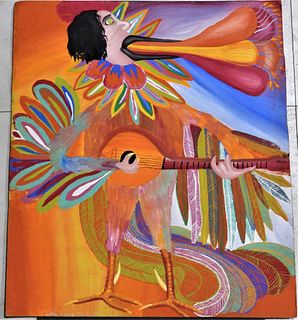Russian school, of the Old Believers, end of the XVIII century. "Resurrection of Christ, Christ's Descent into Hell". Tempera, gold leaf on board.
Lot 116
About Seller
Setdart Auction House
Carrer Aragó 346
Barcelona
Spain
Setdart Subastas was born in 2004 and is currently the first online art auction in Spain with solidity, prestige and reliability guaranteed by our more than 60,000 users. Setdart has a young, dynamic and enterprising team ready to successfully manage the purchase and sale of art works through custom...Read more
Estimate:
EUR€1,200 - EUR€1,500
$1,224.49 - $1,530.61
Absentee vs Live bid
Two ways to bid:
- Leave a max absentee bid and the platform will bid on your behalf up to your maximum bid during the live auction.
- Bid live during the auction and your bids will be submitted real-time to the auctioneer.
Bid Increments
| Price | Bid Increment |
|---|---|
| EUR€0 | EUR€10 |
| EUR€200 | EUR€25 |
| EUR€500 | EUR€50 |
| EUR€1,000 | EUR€100 |
| EUR€3,000 | EUR€200 |
| EUR€5,000 | EUR€500 |
| EUR€10,000 | EUR€1,000 |
| EUR€20,000 | EUR€2,000 |
| EUR€50,000 | EUR€5,000 |
About Auction
By Setdart Auction House
Nov 3, 2021
Set Reminder
2021-11-03 08:00:00
2021-11-03 08:00:00
America/New_York
Bidsquare
Bidsquare : OLD MASTERS
https://www.bidsquare.com/auctions/setdart-auction-house/old-masters-7786
Setdart Auction House sofia@setdart.com
Setdart Auction House sofia@setdart.com
- Lot Description
Russian school, of the Old Believers, end of the XVIII century. "Resurrection of Christ, Christ's Descent into Hell". Tempera, gold leaf on board. Measurements: 18 x 14 cm. Descent of Christ to hell is one of the most important representations in Christian iconography. This passage was known in Ancient Rus since the XI century, although it obtained maximum popularity in the second half of the XIV century. Iconography of this New Testament passage finally developed in the 17th century in Moscow workshops. In this period, the icon reached its maximum complexity, combining the passages of the New and Old Testament, and in turn, composing in one the scenes of the resurrection and the descent of Christ to hell. The icon of interest, a canonical image established in the 17th century, represents the resurrection and the descent of Christ into hell simultaneously. The dynamic composition of this small icon has an ascending character, achieved through the superimposition of the saints' nimbuses, which lead the viewer's gaze from the broken portal of hell to the figure of Christ enclosed in the magic mandorla, this being the main image of the whole composition. The mastery of this anonymous painter in depicting architectural and natural details, as well as his use of color, is fascinating. In the painting of Russian icons, color has a very important symbolic charge, sometimes deeper than the images themselves. In the case of the auctioned piece, the predominance of red tones over the rest of the range is evident. The symbolism of red is very heterogeneous, and this icon is a clear example of this, since at the same time it represents both the Passion of Christ and identifies the martyrs with their red chiton, and serves to mark the borders of hell, represented by the open mouth of a monstrous dragon. On the outer border of the icon can be found its title. All the characters are accompanied by the inscriptions, and hold the hand in the position of blessing with two fingers. These features, together with the visual appearance and general stylistics of the icon, lead to the conclusion that it may belong to the workshops of the Old Believers, settled mainly in the Pomorie and Ural area.
- Shipping Info
-
In-house shipping available. Please inquire at admin@setdart.com.
-
- Buyer's Premium



 EUR
EUR CAD
CAD AUD
AUD GBP
GBP MXN
MXN HKD
HKD CNY
CNY MYR
MYR SEK
SEK SGD
SGD CHF
CHF THB
THB





















